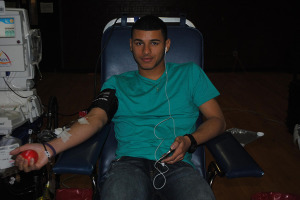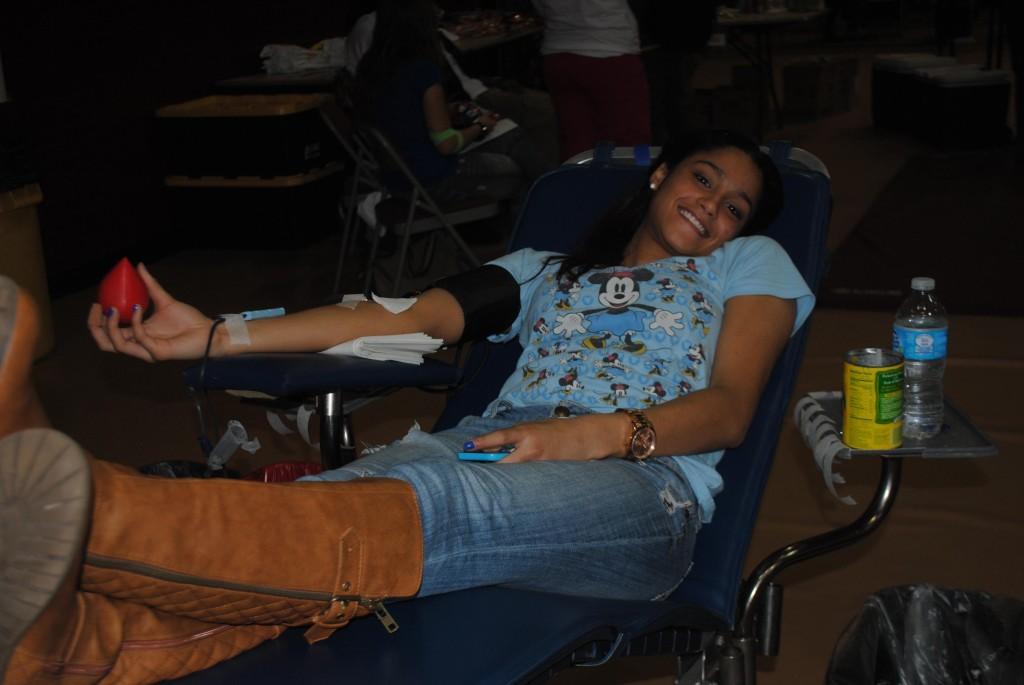The Flow of the Spring Blood Drive
In both the spring and fall, students at DMAE may come across a peculiar-looking sight in the North Gym. Towering machines crowding empty spaces, students sitting on reclining chairs with wires strapped across their arms, volunteers bustling about, everyone sporting a wide smile. To typical onlookers, the Dwight Morrow Blood Drive is a sporadic occasion that suspends gym class. To those involved, however, the blood drive is a biannual opportunity to provide for those in need of blood. Twice a year, they get to help people overcome ailments. Twice a year, they get to save someone’s life.
“There’s always someone who needs blood,” explained senior Diasia Capers who understands the importans of giving blood. “I had family members who had cancer,” she added seriously.
Established by nurse Barbara Manche eight years ago, the blood drive was conceived in honor of Nicholas Tolliver, a 5 year old boy who had been battling leukemia. Ms. Manche, along with science teacher John Jasinski, organized biannual events in the North Gym where eligible students of DMAE could stop by for an hour to donate their blood. Typically, 50 to 60 pints of blood are collected per drive, and the Blood Drive itself costs the district no money; the Community Blood Council distributes approximately $1,000 of scholarship money to run it. To Ms. Manche, the overall event is a good way to expose students to the concept of giving blood. 
“It’s such a valuable asset, and kids really need to be introduced to it, and realize it’s not a scary thing, and that you’re actually helping people,” Ms. Manche said. “I mean, you’re actually saving lives.”
As more and more students have become informed of the importance of the Blood Drive, the number of applicants continues to rise. Some students, however, are ineligible to donate blood and are thus turned down.
“Sometimes people are rejected because they have a cold or have slight anemia,” Mr. Jasinski said. “But we are still thankful for those students who try to donate.”
Among students who were rejected was junior Zeline LaCap, who was told she ineligible to donate in this year’s spring blood drive.
“I felt disappointed. I wanted to donate, but then I was told I was too light,” she said.
Still, Zeline expressed her desire to become a donor if she were to become eligible in the future. On the other hand, students who were eligible and have previously participated in the Blood Drive expressed the reason behind their involvement.
“There was an assembly about the Blood Drive, and I was told there was barely anyone who actually donated blood,” junior Zaneta Zachwieja said. “I heard that Englewood only donated small amounts of blood even for its population so I wanted to change that. That’s what motivated me.”
The increased motivation for students to participate in these events has seen above par results. This year, the DMAE campus collected a total of 66 pints of blood, 6 pints above the initial expectation. The consistently high results make the blood drive a triumph, but according to Mr. Jasinski, there are other intangible benefits of holding the event.
“It has always been a successful event and it can make a difference by further helping to unite our campus as one school,” he said.
The DMAE Blood Drive had been a part of campus life for years, and as the event winds down to its ten-year anniversary, its founders Ms. Manche and Mr. Jasinski anticipate even greater things for it to come.



